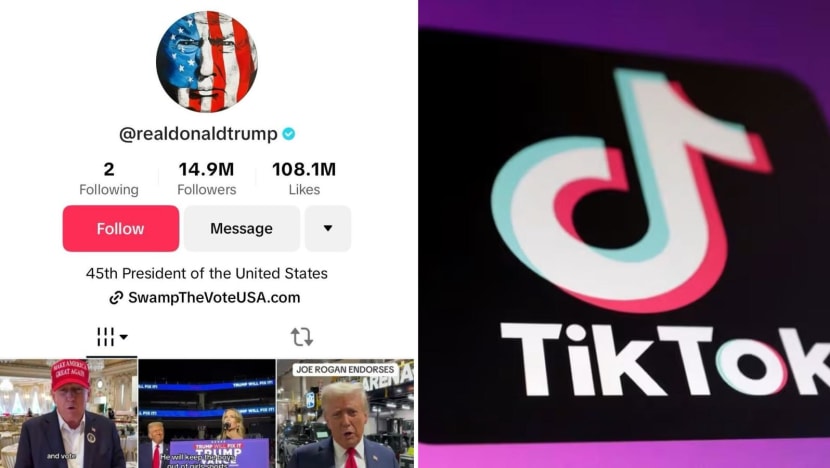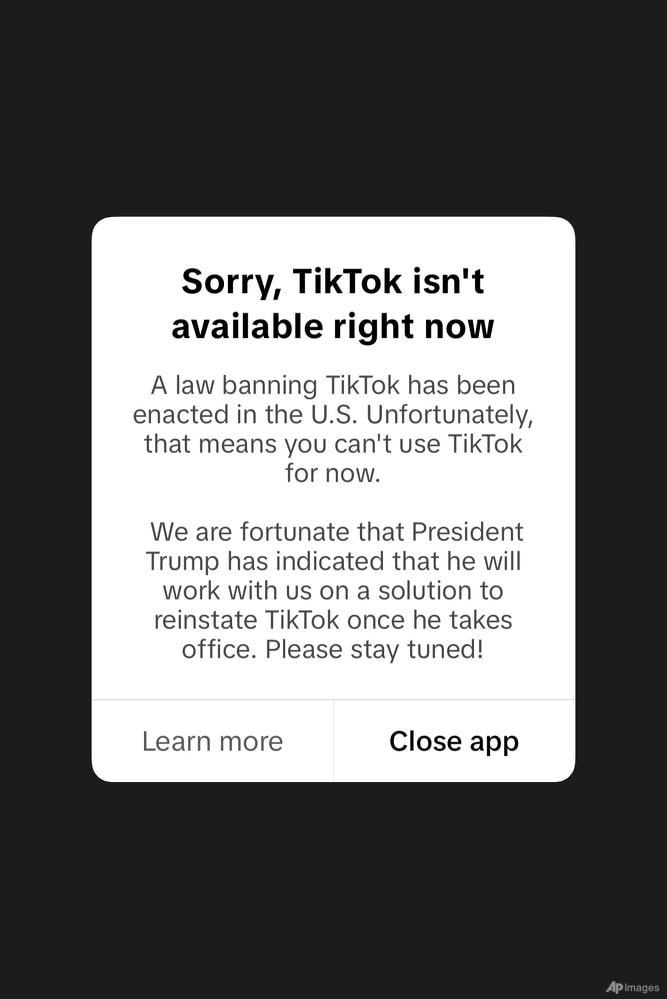Advertisement
Trump wants to “make a deal” to save the popular Bytedance app.

From foe to friend, TikTok and Donald Trump share a long history. (Images: TikTok/@realdonaldtrump; Reuters/Dado Ruvic)

20 Jan 2025 03:00PM (Updated: 20 Jan 2025 04:52PM)
SINGAPORE: TikTok’s service in the United States was restored on Sunday (Jan 19) after the app initially went dark in response to a federal ban – shutting out millions of American users.
The short-lived blackout, which started on Saturday night, came after the US Supreme Court upheld a law banning TikTok on national security grounds if its Chinese parent company ByteDance does not sell it.
However, the app soon flickered back to life and was online for US users by Sunday afternoon.
It was all thanks to incoming President Donald Trump’s efforts, said the social media platform, crediting the president-elect for the lifeline.
Trump, who previously backed a TikTok ban during his first term, promised to issue an executive order as soon as he takes office, delaying the ban to allow time to “make a deal”.
It appears to be business as usual for now for the wildly popular app, but its continued survival is not guaranteed.
What’s next for TikTok?
WHAT DID TRUMP DO?
The app appeared to wind down on Saturday, notifying US users that it would be temporarily unavailable.
“A law banning TikTok has been enacted in the US. Unfortunately, that means you can’t use TikTok for now. We are fortunate that President Trump has indicated that he will work with us on a solution to reinstate TikTok once he takes office. Please stay tuned,” it said in a notice to users.
Apple and Google also removed the app from their digital stores, with the companies liable for penalties of up to US$5,000 per user if the app is accessed. Oracle, which hosts TikTok’s servers, was also legally obligated to enforce the ban.
Amid the dismay, Trump came to the rescue by promising to issue an executive order delaying the ban by granting a 90-day extension.
The law allows for a delay of the ban if the White House can show progress toward a viable deal.
“I will issue an executive order on Monday to extend the period of time before the law’s prohibitions take effect, so that we can make a deal to protect our national security,” Trump said on his Truth Social platform.
TikTok thanked Trump for “providing the necessary clarity and assurance to our service providers that they will face no penalties providing TikTok to over 170 million Americans”.
“As a result of President Trump’s efforts, TikTok is back in the US!” the message read on its platform.
The president-elect also later said he “would like the United States to have a 50 per cent ownership position in a joint venture”, arguing that the app’s value could surge to “hundreds of billions of dollars – maybe trillions”.
“By doing this, we save TikTok, keep it in good hands,” Trump wrote, without providing further details. TikTok did not offer any comment on Trump’s suggestion.
At a rally on Sunday evening, Trump hammered home his enthusiasm for saving the app.
“Frankly, we have no choice, we have to save it,” he told the crowd while indicating that there were a “lot of jobs” involved.
“We don’t want to give our business to China, we don’t want to give our business to other people,” Trump told his supporters.
IS TIKTOK REALLY SAFE NOW?
It is unclear what Trump can do to lift the ban for good unless ByteDance ultimately sells.
Mike Gallagher, a Republican from Wisconsin and the author of the Bill behind the ban, said on Sunday that “there is no extension” for TikTok.
“Let me tell you, as the person who wrote the Bill, the extension was within the 270-day window, which closed at 12.01am this morning,” he said on Sunday, adding that only if the president certifies there are “legally binding documents” showing a divestiture is on the way would there be an extension.
“Congress wrote this law to be virtually president-proof,” said Adam Kovacevich, chief executive of industry trade group Chamber of Progress.
Director of Cornell University’s Tech Policy Institute, Sarah Kreps, said there was no evidence ByteDance had made any meaningful progress toward divestiture, “so I don’t see how, by any measure, it would legally meet those conditions”.
“Further, an executive order cannot legally override or cancel a law that Congress passed,” she said.
“Laws enacted through the legislative process have a higher legal standing and an executive order that conflicts with the existing law, the law takes precedence and the executive order would likely be struck down by the courts.”
The outgoing Biden administration said it would leave enforcement of the law to Trump.

And while Trump is being hailed as the app’s saviour, not everyone in his party agreed with efforts to get around the law and “Save TikTok”.
Republican senators Tom Cotton and Pete Ricketts said in a joint statement that there was no legal basis for any kind of extension now that the law has taken effect.
“For TikTok to come back online in the future, ByteDance must agree to a sale that satisfies the law’s qualified-divestiture requirements by severing all ties between TikTok and Communist China,” they added.
Cotton even warned companies not to provide TikTok with technical support.
“Any company that hosts, distributes, services, or otherwise facilitates communist-controlled TikTok could face hundreds of billions of dollars of ruinous liability under the law,” Cotton wrote on X. “Think about it.”
Meanwhile, TikTok remained optimistic with CEO Chew Shou Zi thanking Trump for his “commitment to work with us to find a solution that keeps TikTok available in the United States”, adding that TikTok is “grateful and pleased to have the support of a president who truly understands our platform”.
Chew is also expected to attend Trump’s inauguration with a prime seating location.
HOW DOES TRUMP BENEFIT?
Trump saving TikTok represents a change in stance from his first term in office.
In 2020, he aimed to ban the app over concerns the company was sharing Americans’ personal info with the Chinese government.
But the app now has a fan in Trump who has since credited TikTok with connecting him to younger voters. He joined the platform in June 2024 and has since amassed nearly 15 million followers.
For now, Trump can take credit for reviving the app that is especially popular with younger Americans – with there only being an upside for him now.
If the ban ends up being enforced, Trump will say it was on outgoing President Joe Biden’s watch, said Bill Bishop, a China expert.
“And if it does come back then Trump is a saviour. And he will be rewarded both by users” as well as the company, which he said is now “beholden to Trump” and will have an incentive to make sure content on the platform is favourable to him, Bishop added.
“It was a brilliant marketing stunt for both TikTok and incoming president Donald Trump,” Jasmine Enberg, an analyst with market research firm Emarketer, said. “By abruptly shutting off service, TikTok proved how unpopular the ban was among its users.”
TikTok may still be sold with a number of suitors interested in the company.
Former Los Angeles Dodgers owner Frank McCourt has expressed interest in the business that analysts estimate could be worth as much as US$50 billion. Media reports say Beijing has also held talks about selling TikTok’s US operations to billionaire and Trump ally Elon Musk, though the company has denied that.
US search engine startup Perplexity AI submitted a bid on Saturday to ByteDance for Perplexity to merge with TikTok US, a source familiar with the company’s plans told Reuters. Perplexity would merge with TikTok US and create a new entity by combining the merged company with other partners, the person added.
Privately held ByteDance is about 60 per cent owned by institutional investors such as BlackRock and General Atlantic, while its founders and employees own 20 per cent each. It has more than 7000 employees in the US.
